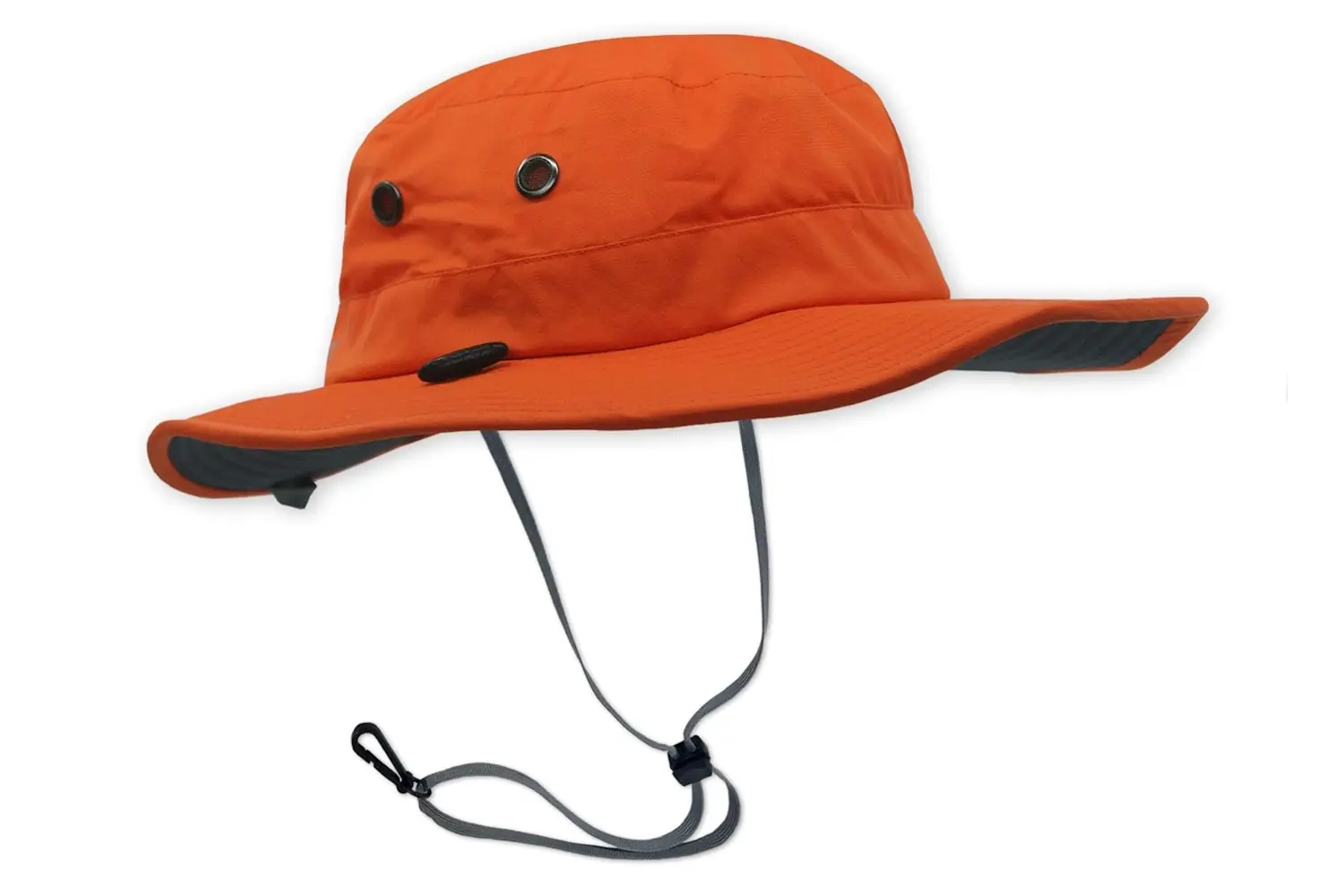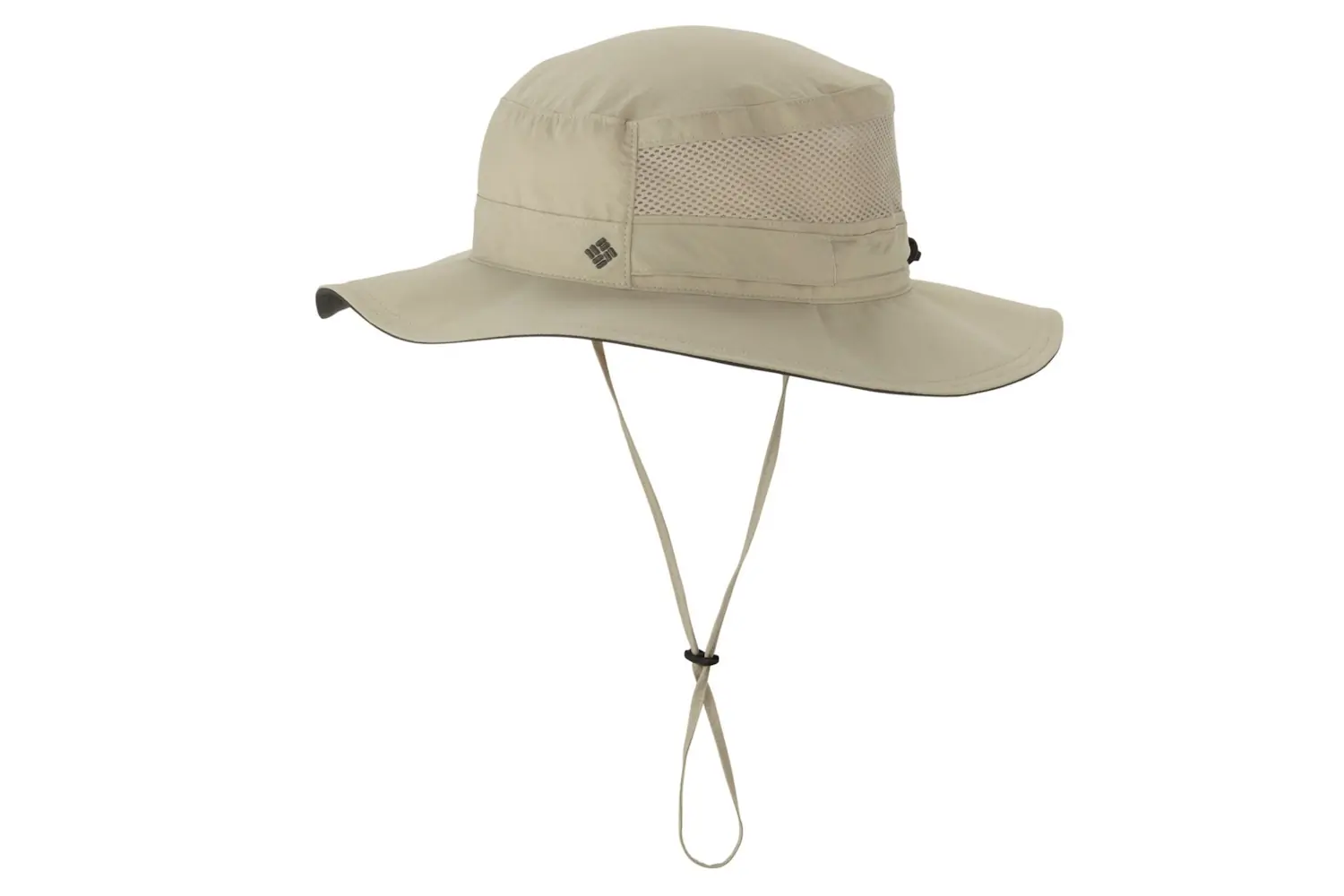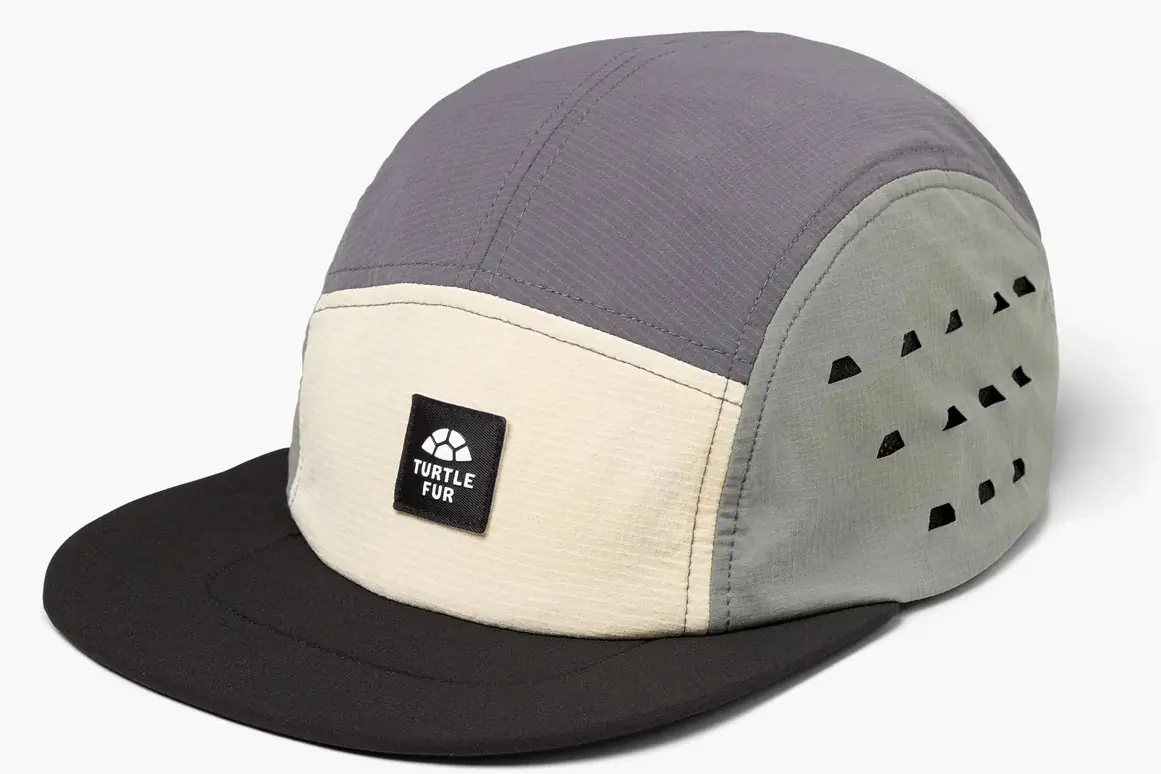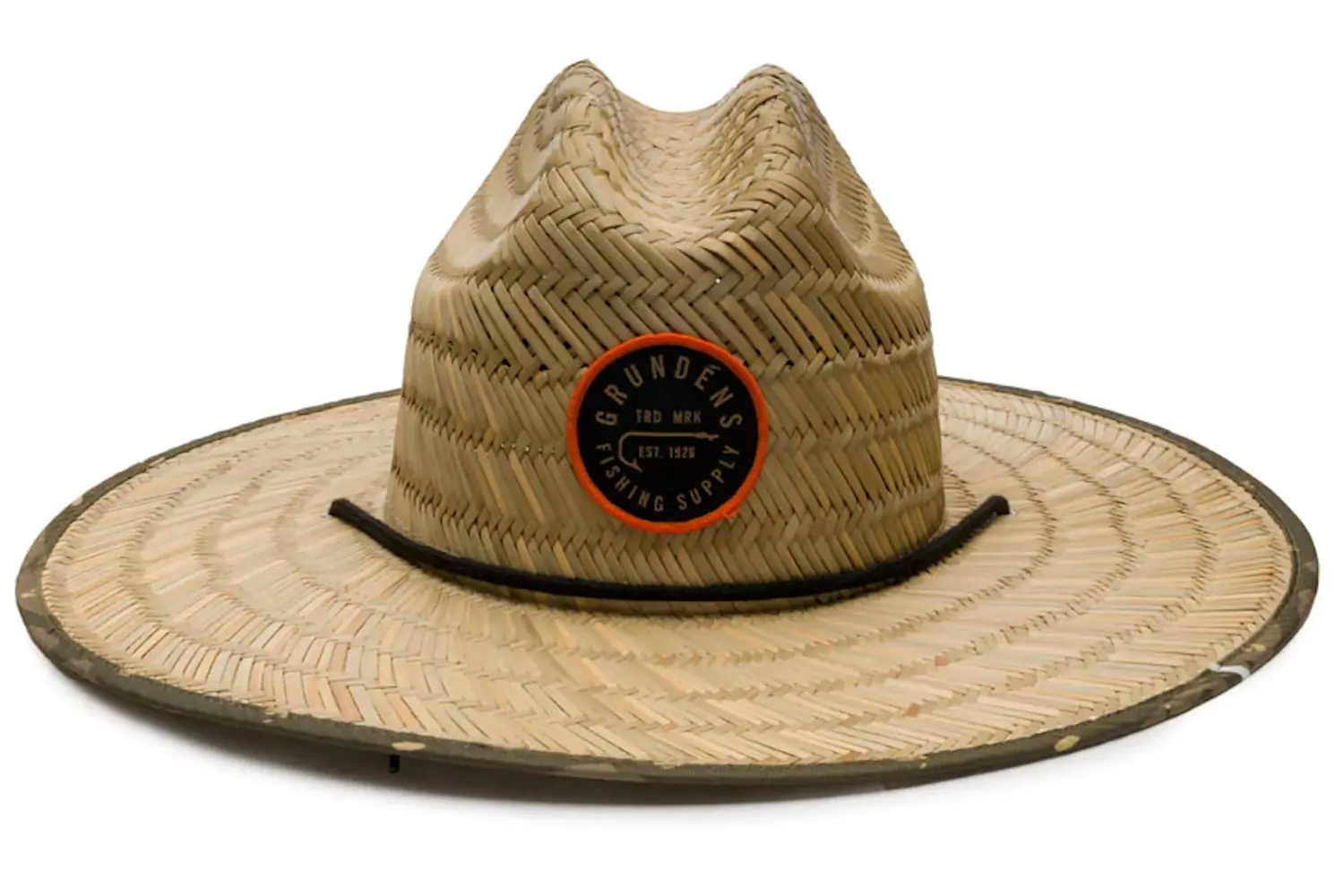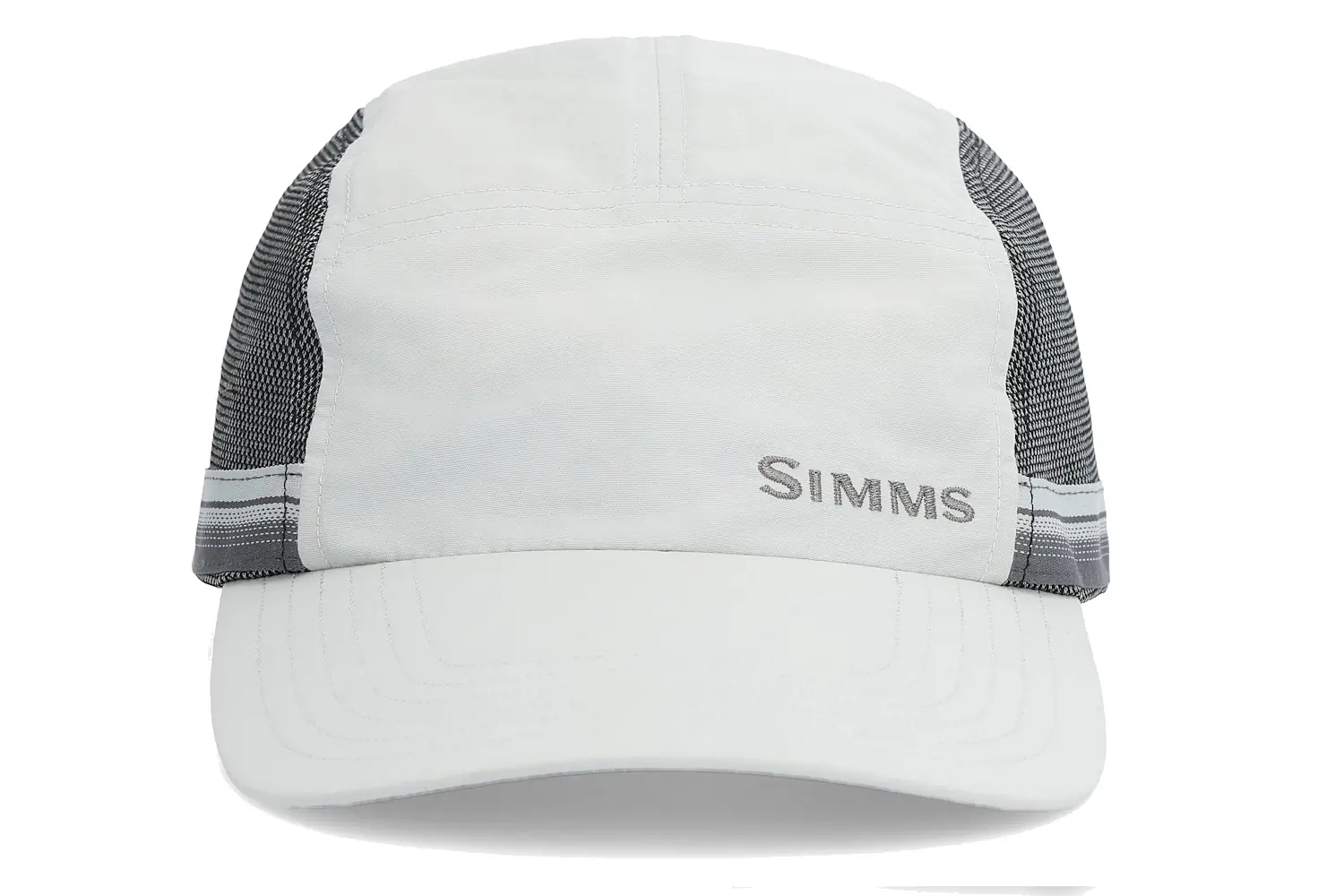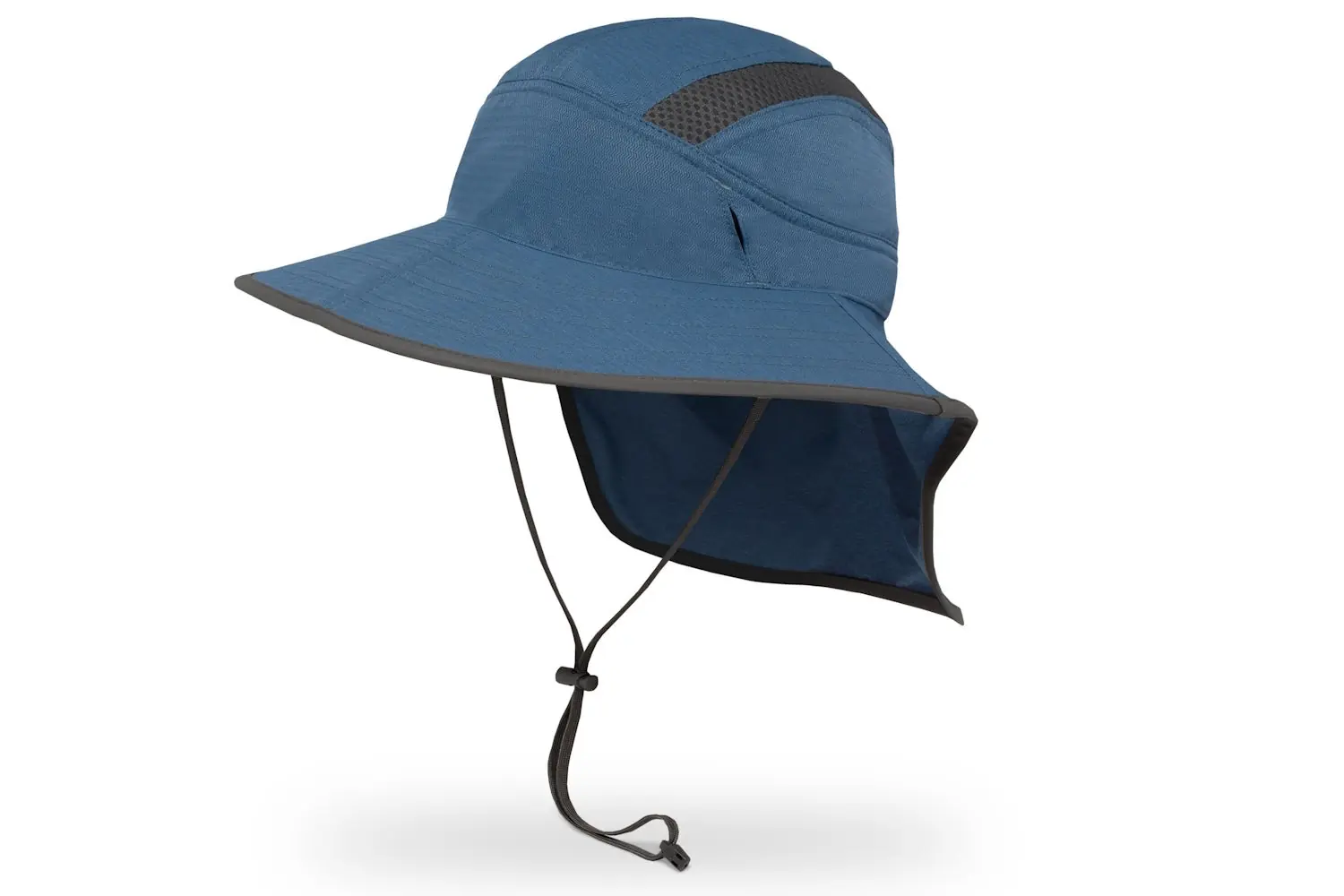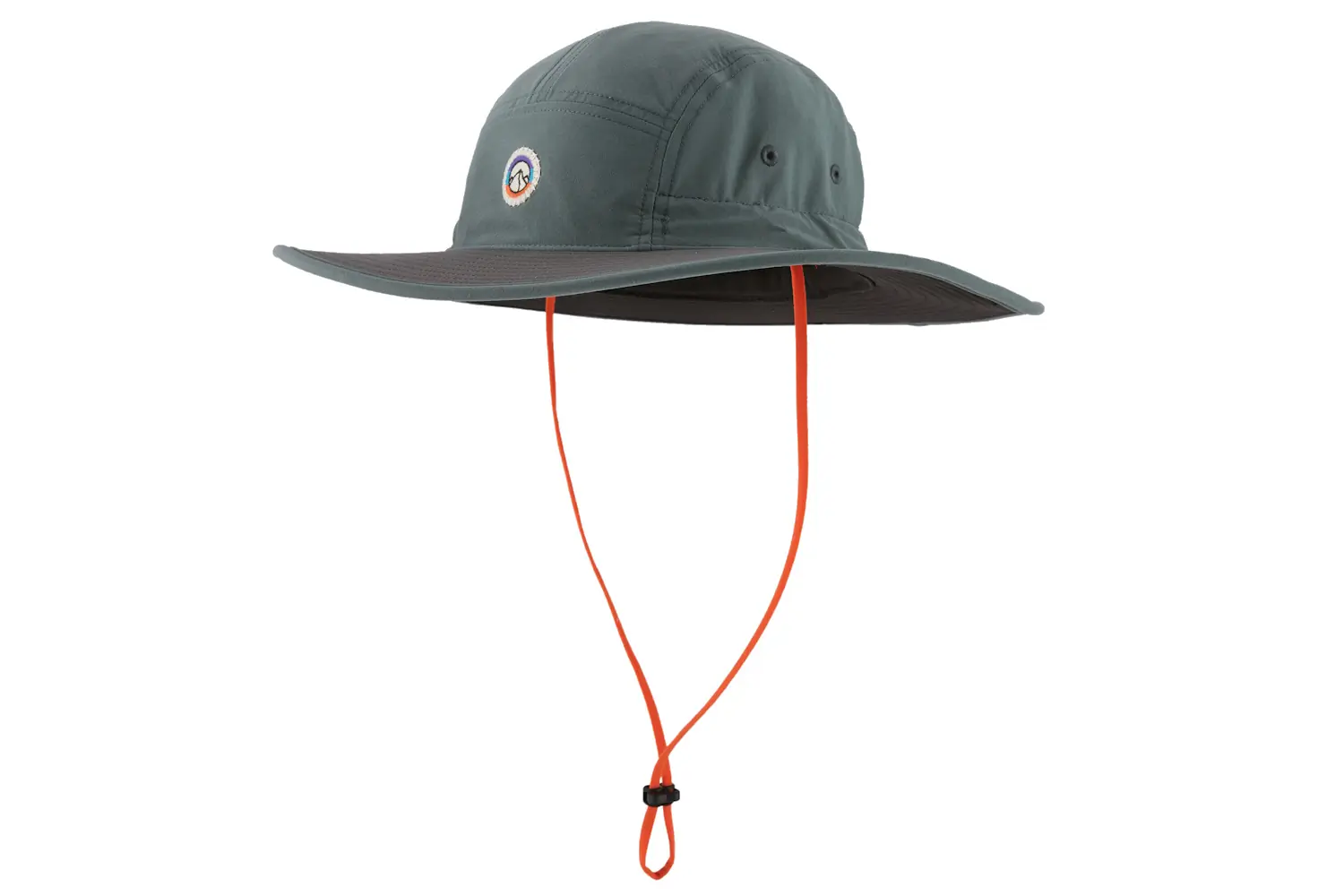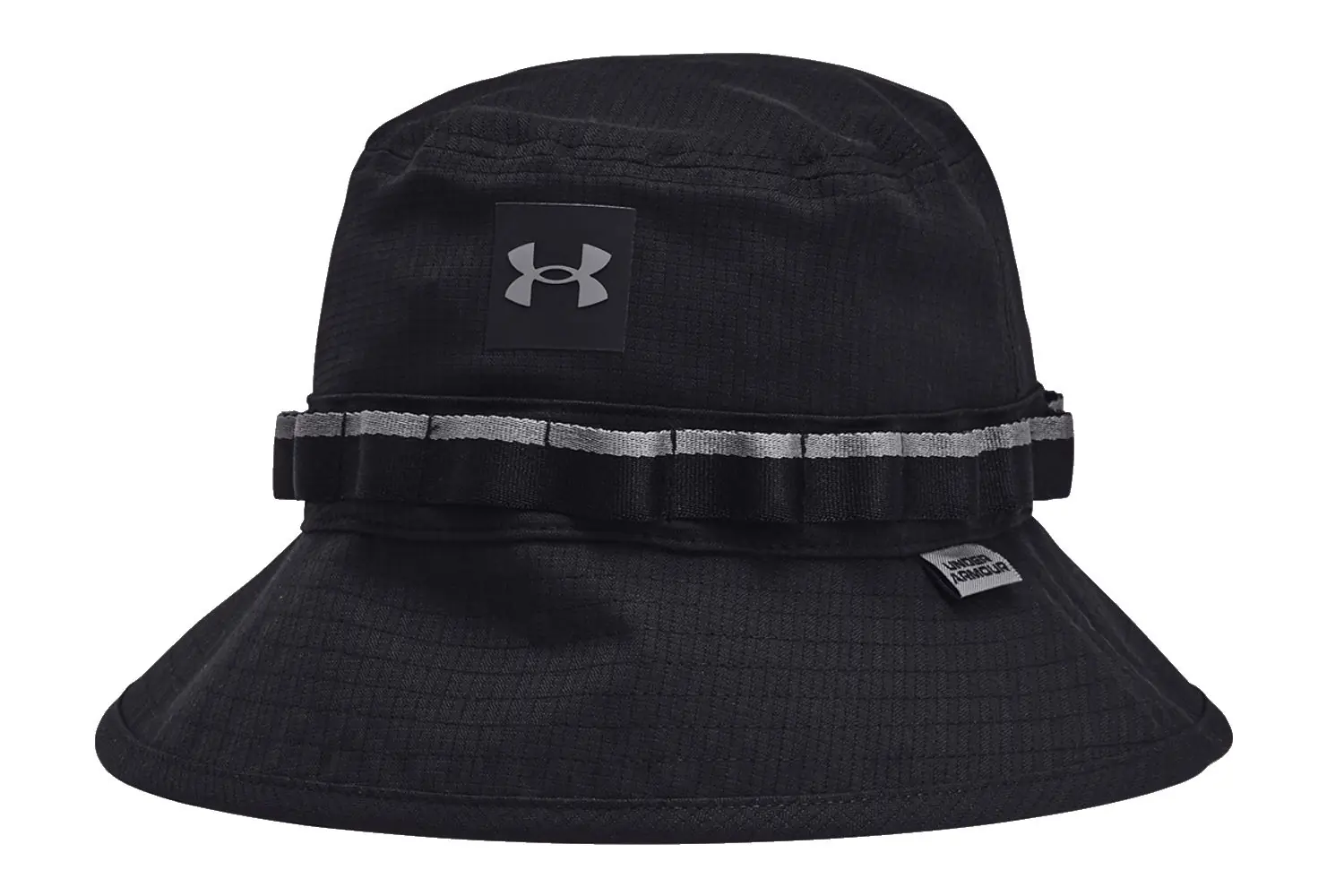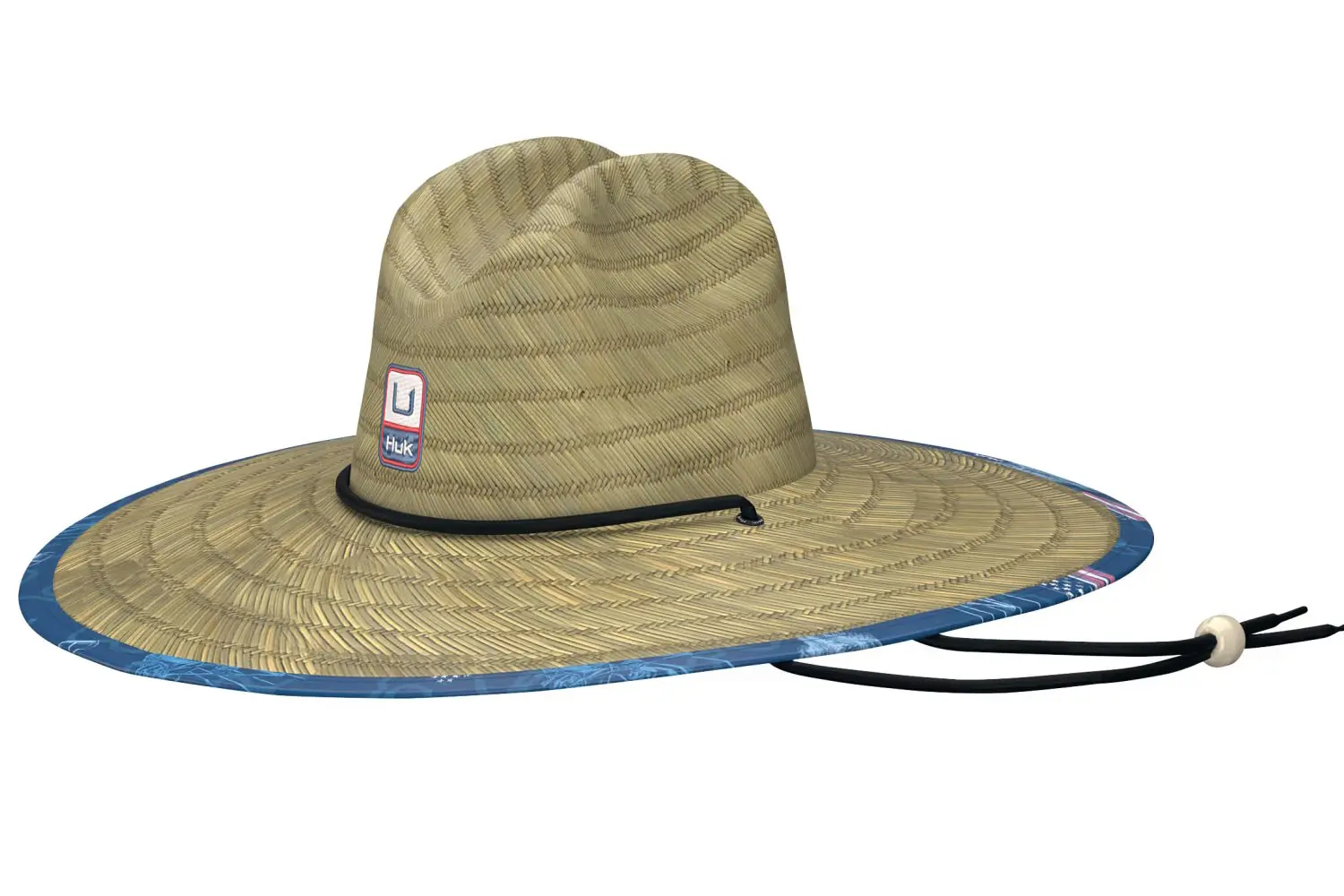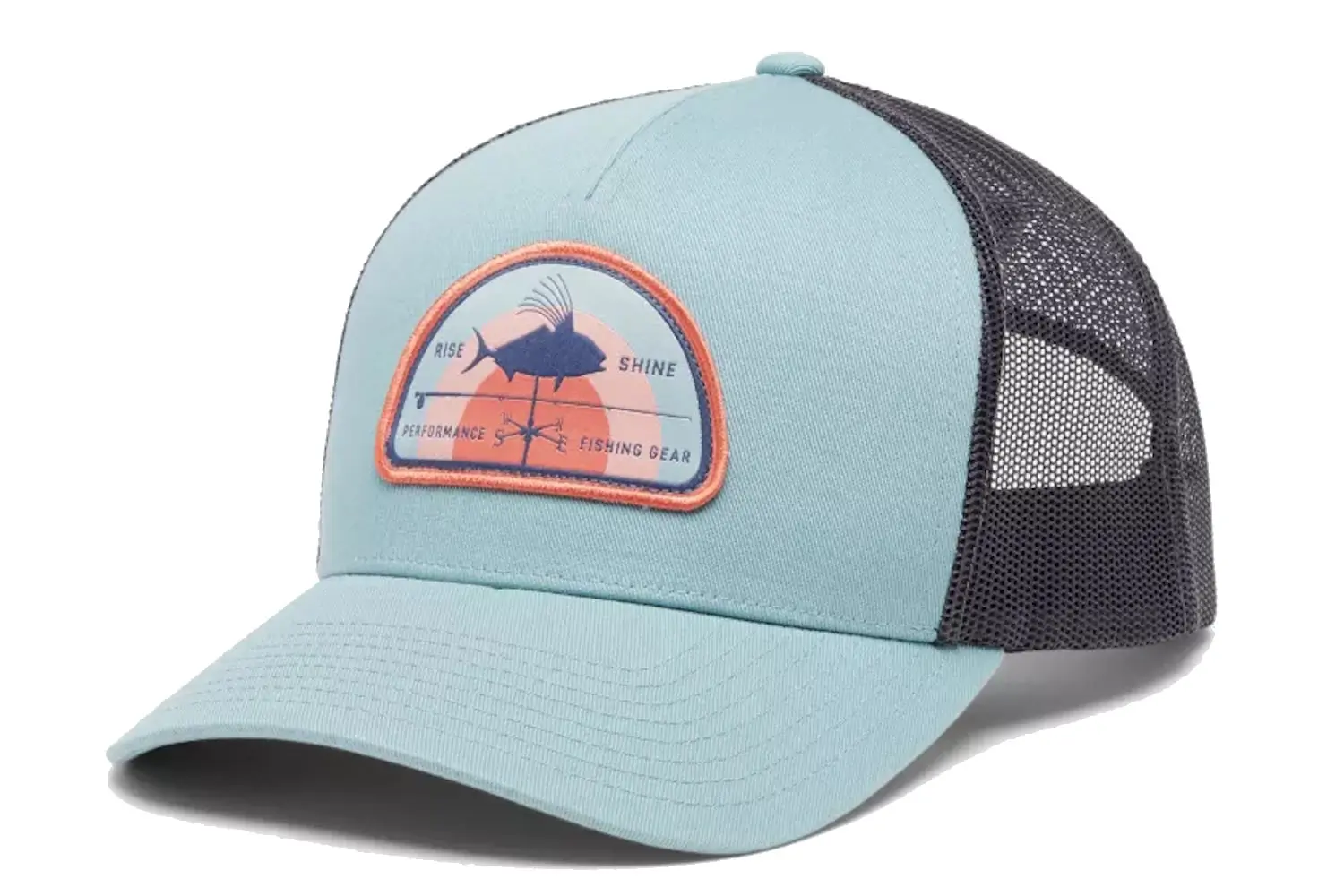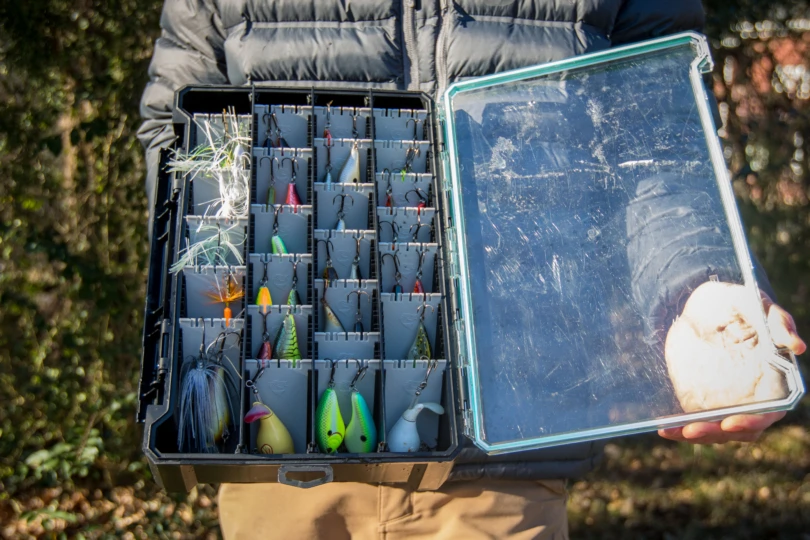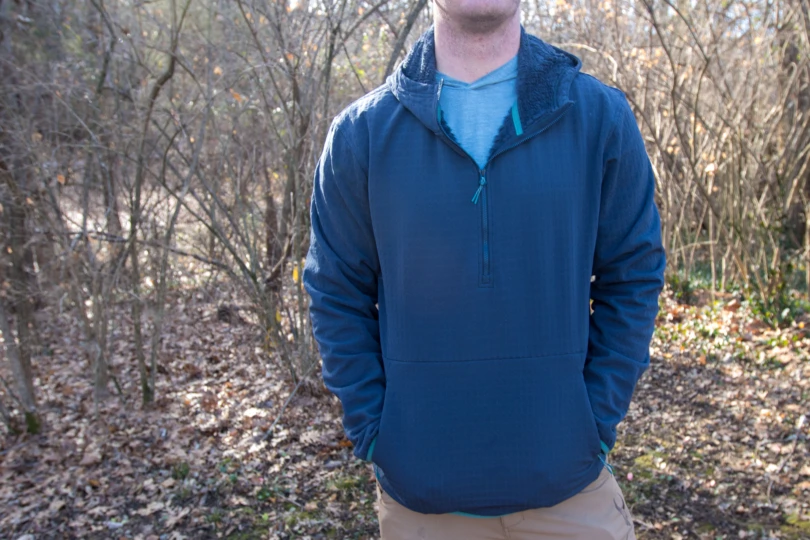What in the world is a fishing hat? That term seems like something a marketing team would create to target old men who are bored in retirement. In the past, those were the only people we knew who had a hat specifically for a day of fishing. We just wore whatever hat we had lying around.
That’s a bit of a paradox coming from anglers, a group that tends to be one of the worst types of gear hoarders. We buy specialized shirts and pants, entirely overengineered rods, and fish finders that cost more than your high school daily driver. One would think anglers would want the best out of something they use every single day. We do. So while a hat may seem like a trivial piece of gear, it can provide some very real benefits.
Our experts have been landing fish for decades, testing a wide range of angling products from the best fishing glasses to the best rods and reels. Our lead tester, Ben Hickok, has over 2 decades of outdoor experience, including rock climbing, backpacking, and his great passion for fishing. His combined experience and informed opinions let us narrow product selections to great products, separating mediocre products, gimmicks, and casualwear.
Finding a comfortable and useful fishing hat can be difficult, especially when shopping online and without the ability to try any on. Still, when you find the right one, you’ll wonder why you’ve waited so long to get one. We analyzed brim sizes, materials, fabric treatments, design pros and cons, special features, comfort, and fit to help you narrow your search and graduate from casual to performance wear.
Below are the top fishing hats based on our testing and evaluations. We have highlighted hats that fit different anglers and needs. We’ve also included a thorough buyer’s guide, a comparison chart, and an FAQ section for those who are trying to understand the what and why of fishing hats.
Editor’s Note: We updated this guide on March 28, 2025, to include the Turtle Fur Way Out 5 Panel hat as an option for anglers on motor boats.
The Best Fishing Hats of 2025
Shelta Seahawk Performance Sun Hat
- Style: Boonie
- Brim Size: Medium
- Weight: 3.8 oz.
- Materials: 100% Recycled Polyester body; Polyester mesh
- UPF Rating: UPF 50+
- Floats: Yes
- Adjustable Headband: Yes
- Adjustable Chin Strap: Yes (Removable)
- DWR Treated: Yes
- Extras: Rigid Bill
Pros
- Great ventilation
- Comfortable
- Rigid bill
- Removable chin strap
Cons
- A bit pricey
- Heavier than other Boonie hats
Columbia Bora Bora II Booney
- Style: Boonie
- Brim size: Medium
- Weight: 2.6 oz.
- Materials: Nylon
- UPF rating: UPF 50
- Floats: Yes
- Adjustable headband: Yes
- Adjustable chin strap: Yes
- DWR treated: Yes
- Extras: None
Pros
- Inexpensive
- Great ventilation
- Lightweight
- Comfortable
Cons
- Floppy brim
Turtle Fur Way Out 5 Panel Hat
- Style: Cap
- Brim size: Medium (5")
- Weight: 2.1 oz.
- Materials: 50% recycled polyester, 45% recycled nylon, 5% spandex
- UPF rating: UPF 50+
- Floats: Yes
- Adjustable headband: Yes
- Adjustable chin strap: No
- DWR-treated: No
- Extras: Floating bill, quick-adjust cordlock closure
Pros
- Quick-fit adjustment
- Stays on your head at high boat speeds and in high winds
- Highly breathable
- Brim floats
Cons
- One style
- Limited colors
Grundens Waterman Straw Hat
- Style: Straw Hat
- Brim Size: Large
- Weight: 4.6 oz.
- Materials: Natural Straw, Cotton underbrim
- UPF Rating: None
- Floats: Sort of
- Adjustable Headband: Elastic
- Adjustable Chin Strap: Yes
- DWR Treated: No
- Extras: Dark Underbrim
Pros
- Lots of sun protection
- Comfortable
Cons
- Not waterproof
Simms Superlight Flats Cap
- Style: Cap
- Brim Size: Large (bill)
- Weight: 3.68 oz.
- Materials: Nylon and Polyester
- UPF Rating: UPF 50
- Floats: No
- Adjustable Headband: Yes
- Adjustable Chin Strap: None
- DWR Treated: Yes Teflon
- Extras: Extra long bill
Pros
- Super light
- Extremely comfortable
Cons
- No ear or neck protection
- Looks a bit goofy
Sunday Afternoons Ultra Adventure Hat
- Style: Adventure, Clamshell
- Brim Size: Medium
- Weight: 2.6 ounces
- Materials: 88% Nylon, 12% Polyester Dobby
- UPF Rating: UPF 50+
- Floats: No
- Adjustable Headband: Yes
- Adjustable Chin Strap: Yes
- DWR Treated: Yes
- Extras: Sunglasses Holder
Pros
- Large neck coverage
- Folds down
Cons
- Floppy cape
- Semi-floppy brim
Patagonia Quandary Brimmer Hat
- Style: Boonie
- Brim Size: Medium
- Weight: 4.8 oz.
- Materials: 99% Recycled Nylon, 99% Recycled Polyester
- UPF Rating: UPF 50
- Floats: Yes
- Adjustable Headband: Yes
- Adjustable Chin Strap: Yes
- DWR Treated: Yes
- Extras: Uses recycled materials and fair trade certified
Pros
- Flexible brim
- Eco-conscious
- Fair trade
Cons
- Small ventilation holes
- Thicker sweatband
- Bowl-shaped crown
- Expensive
- Style: Bucket
- Brim Size: Medium
- Weight::
- Materials: 100% Polyester
- UPF Rating: None
- Floats: No
- Adjustable Headband: No
- Adjustable Chin Strap: Yes
- DWR Treated: No
- Extras: Gear loops
Pros
- Good fit
- Strong sun protection
Cons
- Flimsy brim
- Brim obstructs visibility
- Style: Straw Hat
- Brim Size: Large
- Weight: 5.1 oz.
- Materials: Natural Straw, Cotton under brim
- UPF Rating: None
- Floats: Sort of
- Adjustable Headband: Elastic
- Adjustable Chin Strap: Yes
- DWR Treated: No
- Extras: Proud Americana Underbrim
Pros
- Lots of sun protection
- Affordable
- Fun
Cons
- Not waterproof
- Not as comfortable as other straw hats
- Style: Cap
- Brim Size: Regular
- Weight: 3.68 oz.
- Materials: Cotton with Polyester Mesh
- UPF Rating: None
- Floats: No
- Adjustable Headband: Snapback
- Adjustable Chin Strap: None
- DWR Treated: No
- Extras: Looks good
Pros
- Casual
- Comfortable
Cons
- No ear or neck protection
- Not weather-resistant
Fishing Hats Comparison Chart
| Fishing Hat | Price | Material | UPF Rating | Floats | DWR Treated |
|---|---|---|---|---|---|
| Shelta Seahawk Performance Sun Hat | $75 | 100% recycled polyester body; polyester mesh | UPF 50+ | Yes | Yes |
| Columbia Bora Bora II Booney | $30 | Nylon | UPF 50 | Yes | Yes |
| Turtle Fur Way Out 5 Panel Hat | $50 | 50% recycled polyester, 45% recycled nylon, 5% spandex | UPF 50+ | Yes | No |
| Grundens Waterman Straw Hat | $40 | Natural straw, cotton underbrim | None | Sort of | No |
| Simms Superlight Flats Cap | $40 | Nylon and polyester | UPF 50 | No | Yes Teflon |
| Sunday Afternoons Ultra Adventure Hat | $50 | 88% nylon, 12% polyester Dobby | UPF 50+ | No | Yes |
| Patagonia Quandary Brimmer hat | $59 | 99% recycled nylon, 99% recycled polyester | UPF 50 | Yes | Yes |
| Under Armour ArmourVent Bucket Hat | $35 | 100% polyester | None | No | No |
| Men’s Huk Fish and Flags Straw Sun Hat | $35 | Natural Straw, Cotton under brim | None | Sort of | No |
| Columbia PFG Uncharted Mesh Snapback Hat | $30 | Cotton with Polyester Mesh | None | No | No |
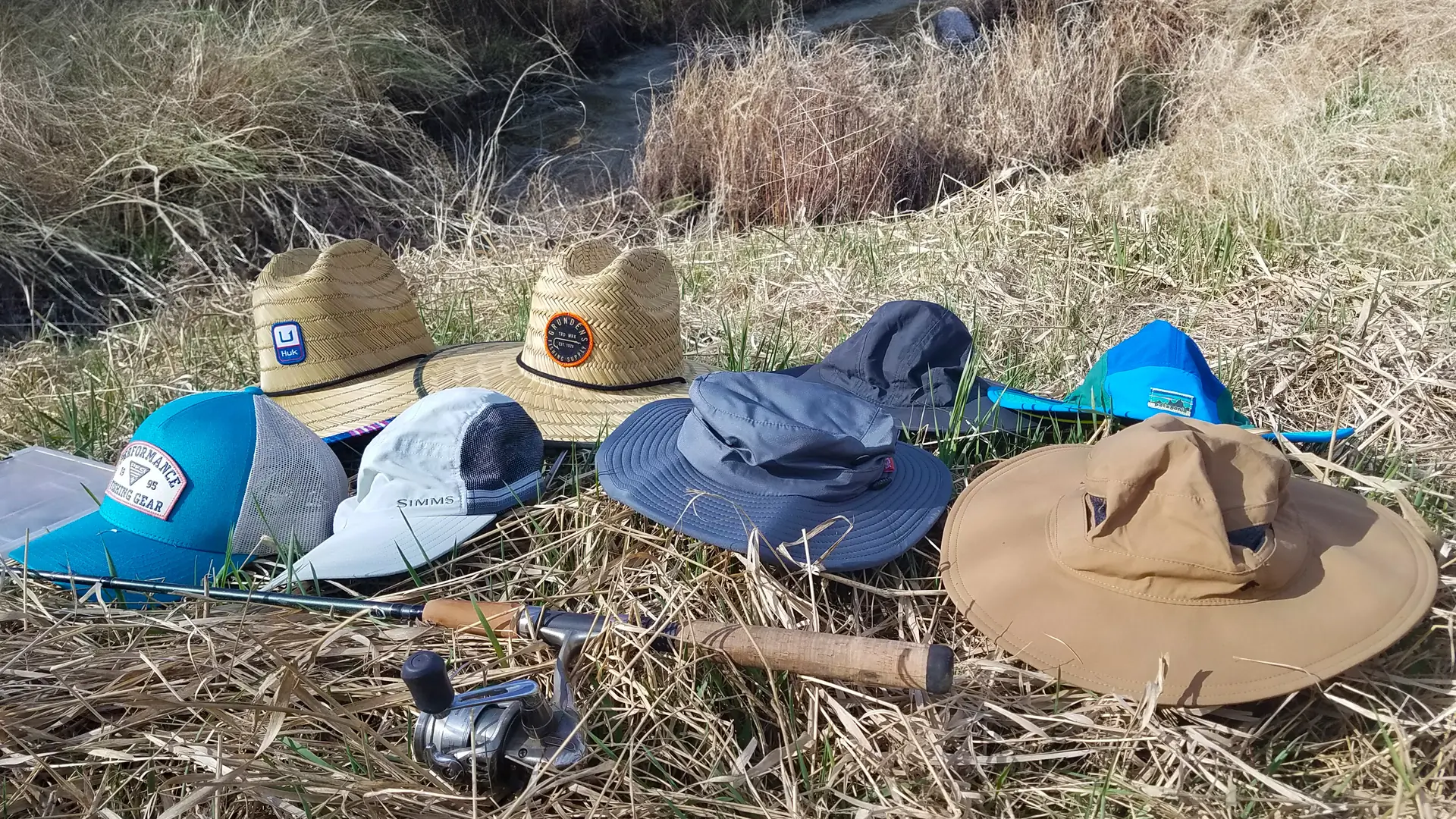
How We Tested Fishing Hats
Our team of outdoor anglers have decades upon decades of collective fishing experience, from baitcasting and spinning, to fly fishing, Tenkara, and even trapping bait and mudbugs. That experience culminates in a lot of different preferences and opinions, but one thing is always clear, staying safe and comfortable with a fishing hat is a must.
A fishing hat can help prevent dangerous health issues, add comfort, and potentially give anglers a small edge with glare reduction. Thus, we focused heavily on the importance of protection from the sun’s UV rays while testing fishing hats.
Author Ben Hickok has put in the time, energy, and mileage, to have a voice when it comes to fishing. He mostly enjoys freshwater fishing in almost every imaginable location and loves to seek out some of the most remote fishing locations to hook beautiful fish.
Pursuits of fish often mean full days in the sun at higher elevations and little shade, floating along in a kayak while getting beat down by the elements from multiple angles, walking high desert creeks looking for a good hole, or fishing through freak mountain storms. Regardless of the pursuit, a fishing hat can be either an indispensable piece of gear or an aggravation you want to stuff into your pack.
Fishing hats have come a long way from the quintessential waterproof, rubbery bucket hat, to incorporate more practical designs and higher performance materials. When you wear a modern fishing hat, you should expect protection from the sun, adequate shedding of rain, and a high level of comfort.
We held hats to those demanding standards when we brought them along on our fishing adventures at different locations in the foothills of Wyoming’s Wind River range this spring. Wyoming’s weather, well-known for a snowstorm one minute and classic blue skies minutes later, provided us with a great environment in which to speedily test hats.
We tested ten different fishing hats, from casual to purpose-driven, on hot, overcast, windy, and even rainy days in various fishing environments. We wore them with backpacks, frame packs, and waders. To further evaluate comfort, we even left them on for the drives to and from fishing spots, to run errands, and to attend social events.
Some hats we forgot about, some got in the way, and others earned some funny looks, but we put in the time in and out of the field to bring you the most unbiased evaluations of some of today’s best fishing hats. If you’re looking for some other fishing gear to keep you out there longer, check out our guide to Best Fishing Waders.
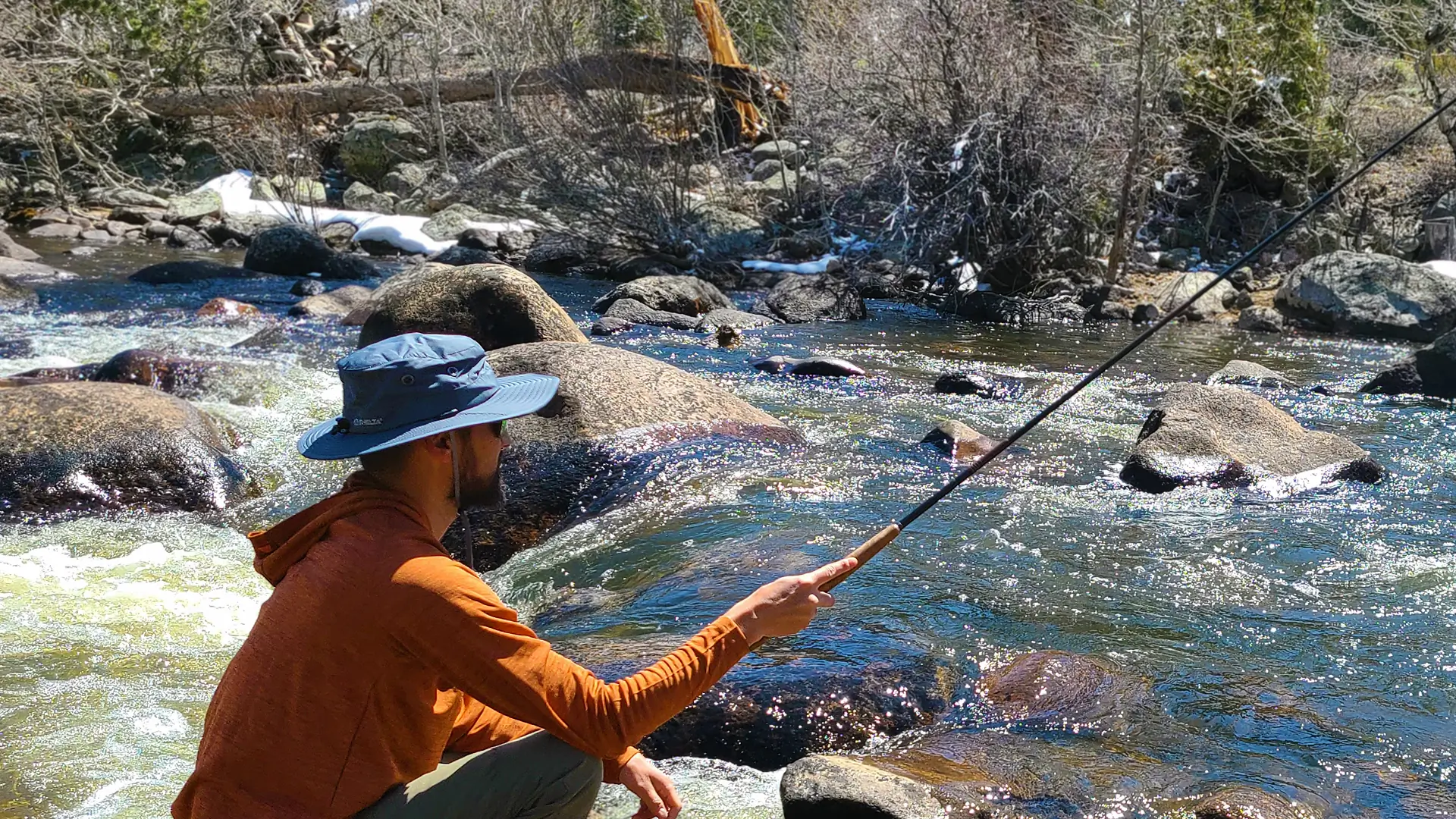



Buyer’s Guide: How to Choose the Best Fishing Hats
When comparing fishing hats, we recommend considering protection from the elements, materials, water resistance, color, design, comfort, and fit.
Protection From the Elements
The first major consideration for a fishing hat is sun protection. The sun’s rays can be harmful. Extended exposure to sunlight can lead to painful sunburns, sunstroke, premature aging, and even skin cancer. A wider brim provides more coverage and better protection from the sun, wind, and rain.
It also helps shield your eyes from glare. In particular, matte, dark, or neutral colors of underbrim materials will knock down glare, improving visibility when spotting fish. However, overly large brims can obstruct your peripheral vision and become cumbersome in windy conditions.
Aim for a brim width that balances the level of protection that makes sense for your fishing style and environment. A medium-sized brim, like found on the Shelta Seahawk Performance Sun Hat or the Simms Superlight Flats Cap, provides different levels of sun protection than a large straw hat.
But, smaller brims are more practical for adventures through thick brush and can more comfortably be worn with a pack. The hybrid brim and cape design of the Sunday Afternoons Ultra Adventure Hat also offers good sun protection while keeping things light and comfortable. For added sun protection, grab some fishing sunglasses.
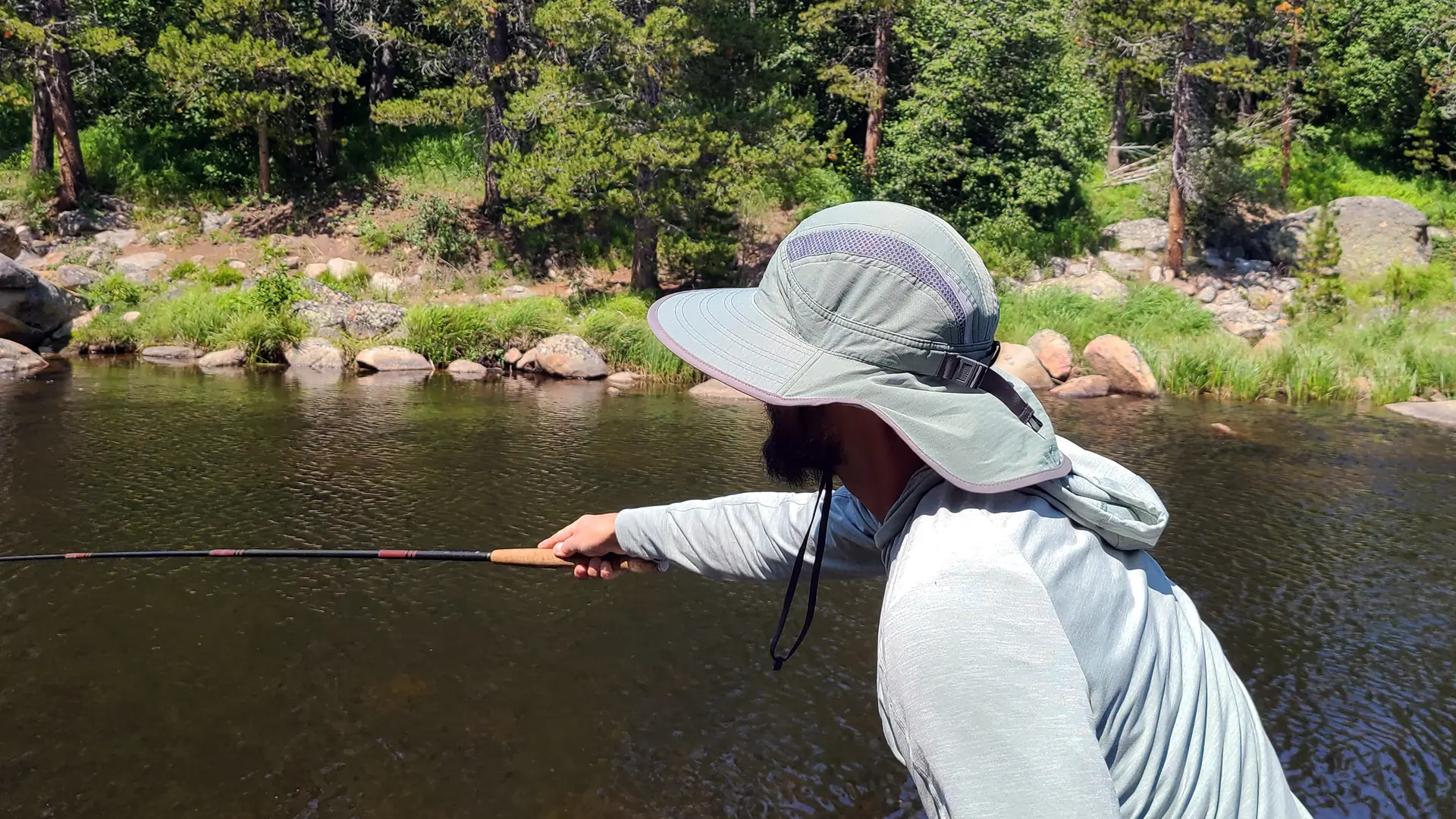



Materials
Fishing hats have come a long way from yesteryear’s cotton, wool, and tweed hats when there were no synthetic fabrics. Today’s materials and any treatments applied to those materials can significantly impact performance and durability.
Additionally, you’ll want to consider hats made from UPF (Ultraviolet Protection Factor) fabric, which offers superior sun protection compared to standard materials, which we’ll touch on in a minute.
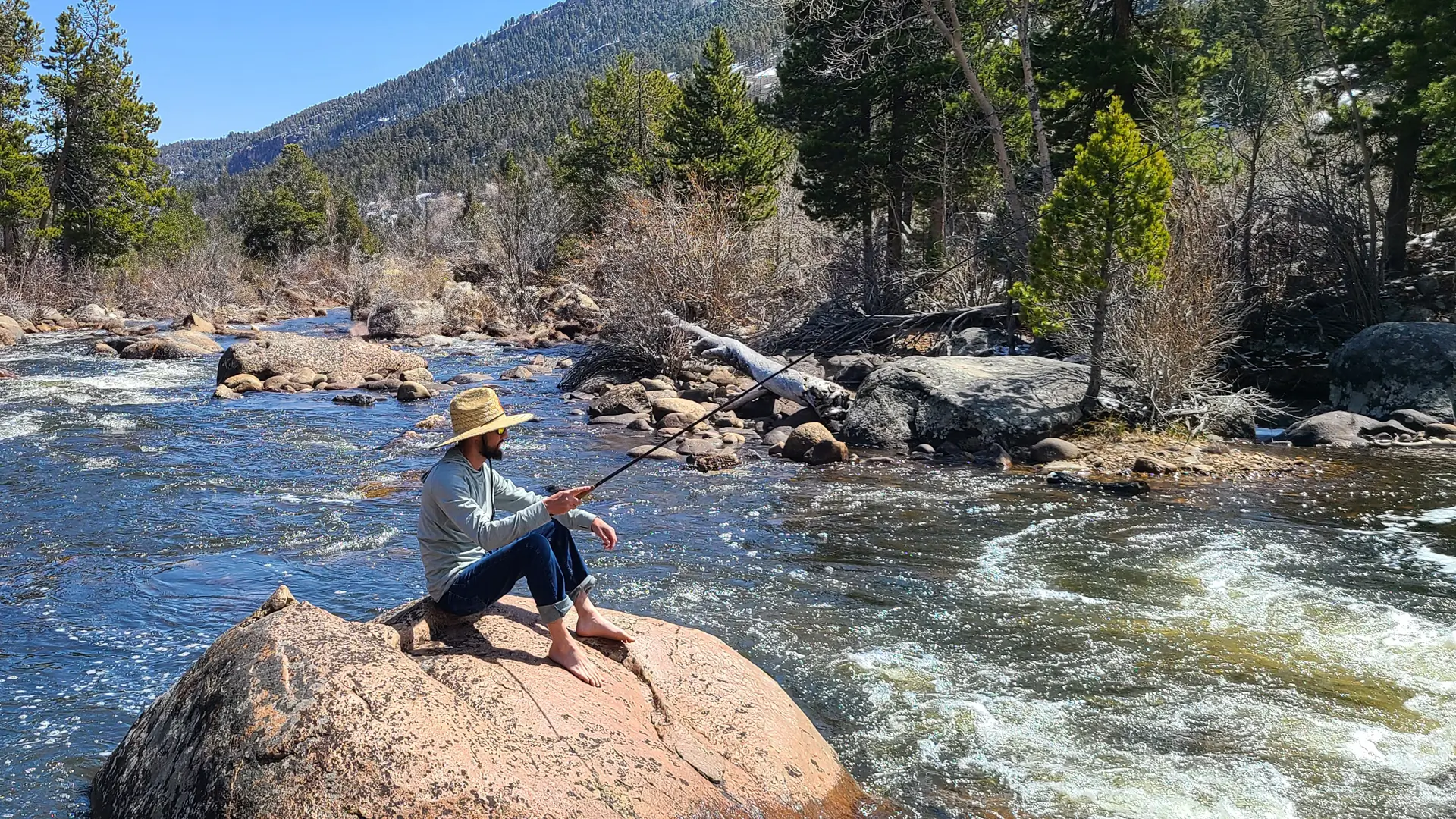



Types of Materials
For most types of fishing, the ideal hat is constructed from lightweight and breathable fabrics like nylon and polyester. A hat design should include poly mesh sections for greater ventilation, sweat dissipation, and cooling, or at a bare minimum include grommets in addition to breathable and moisture-wicking fabrics. Avoid any hat made from a heavy nonbreathable material that will trap heat and sweat.
Straw fishing hats like the Grundens Waterman Straw Hat are popular for good reasons. They provide ample protection from the sun and the weave of natural straw materials provides good ventilation. However, while a straw hat will float when it falls in the water, the straw materials are not meant to hold up to any extended contact with water.
When a straw hat falls into water or gets saturated by rain, it will protect you for a little bit before becoming saturated and floppy. If you get your straw hat wet with anything but rainwater, it is smart to give it a quick rinse with clean, fresh water. Then, place it somewhere, like on a table with the brim flush to the table, where it can dry without losing its shape.
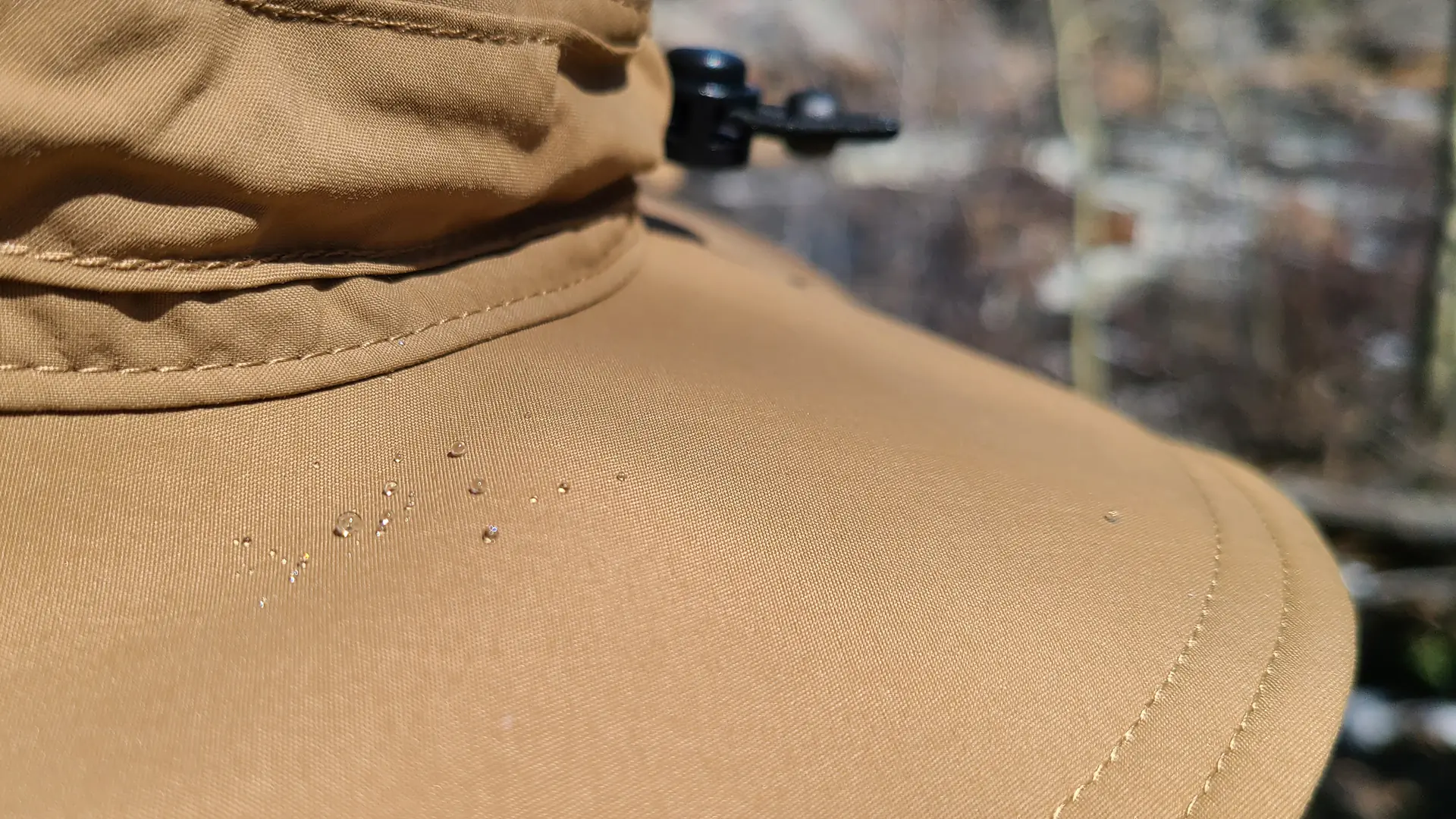



Water Repellants
We have all been or will be in a spring or summer rain shower, hail storm, or snow flurry at some point during our fishing adventures. At those moments you have or will appreciate a hat that helps to keep the moisture off your head, from sticking to and fogging your glasses, and out of your face.
Those situations are why you should buy a fishing hat with a durable water-repellent coating like the Shelta Seahawk Performance Sun Hat and the Patagonia Quandary Brimmer. Even nylon and polyester materials can become saturated and fail to shed water over time.
Flotation
In addition to water-resistant materials and water-repellant treatments, some fishing hats incorporate materials into the brim that cause the hat to float. For example, the Turtle Fur Way Out 5 Panel floats. This feature prevented us from losing this hat when we accidentally dropped it in the water while wading. This can also happen while fishing from a kayak, paddleboard, boat, or any situation where you are surrounded by water.
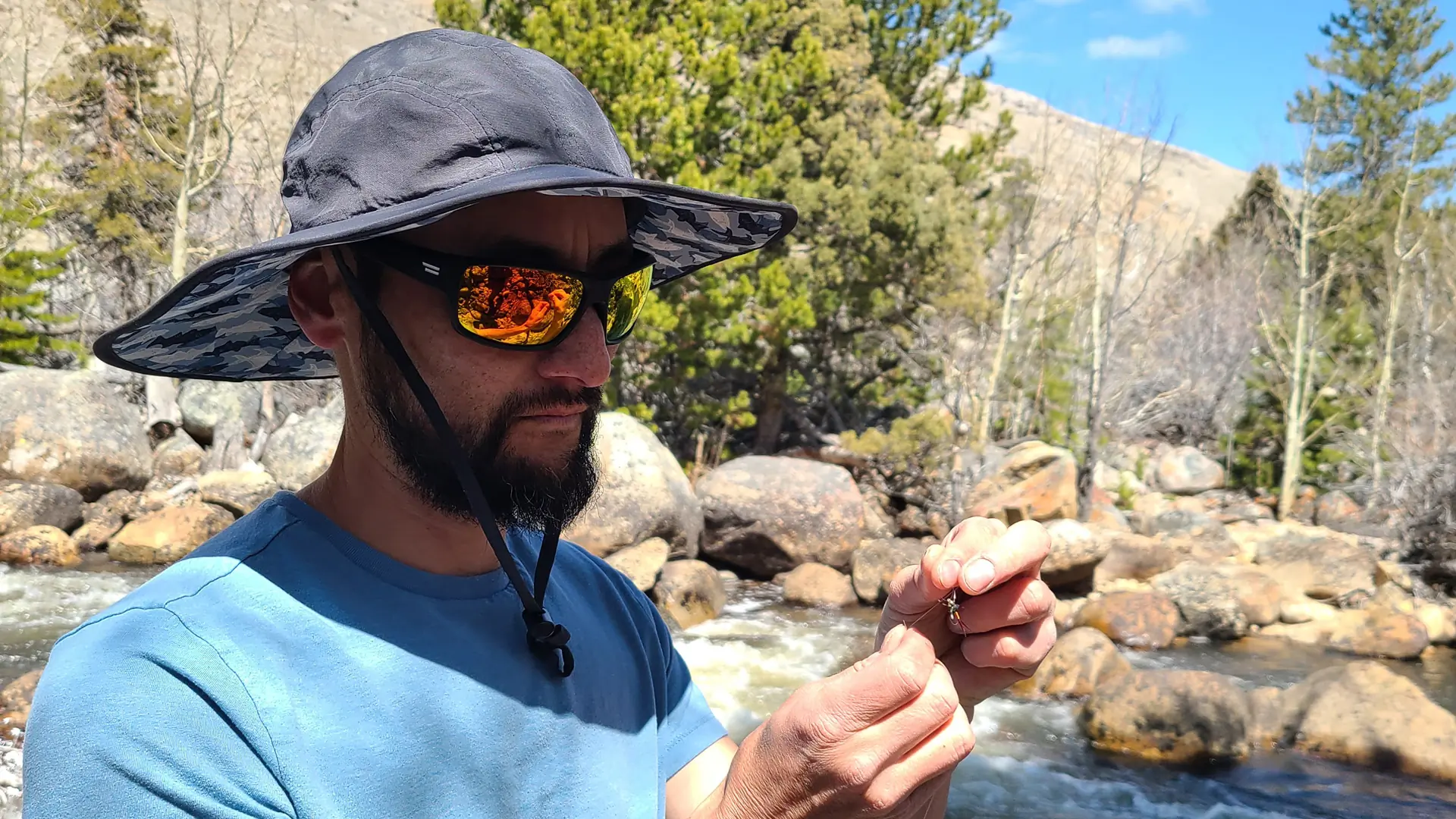



Ultraviolet Protection Factor (UPF)
UPF is a measurement of how much of the sun’s UVA and UVB energy a fabric allows to reach your skin. This is not to be confused with SPF ratings of sunscreen, which are very different. The majority of UPF sun shirt and sun hat ratings you’ll see must have a minimum of UPF 30, but many that we see are UPF 50, which blocks 98% of light, allowing 1/50th of ultraviolet light to penetrate.
The sun’s UV rays can be incredibly harmful. Melasma, a skin condition that causes patches and spotting, is the result of UV exposure or hormonal issues. It may make you feel insecure and while it isn’t physically dangerous, melanoma is deadly. Look for UPF ratings on sun hats, and help prevent potential health issues while you enjoy fishing.
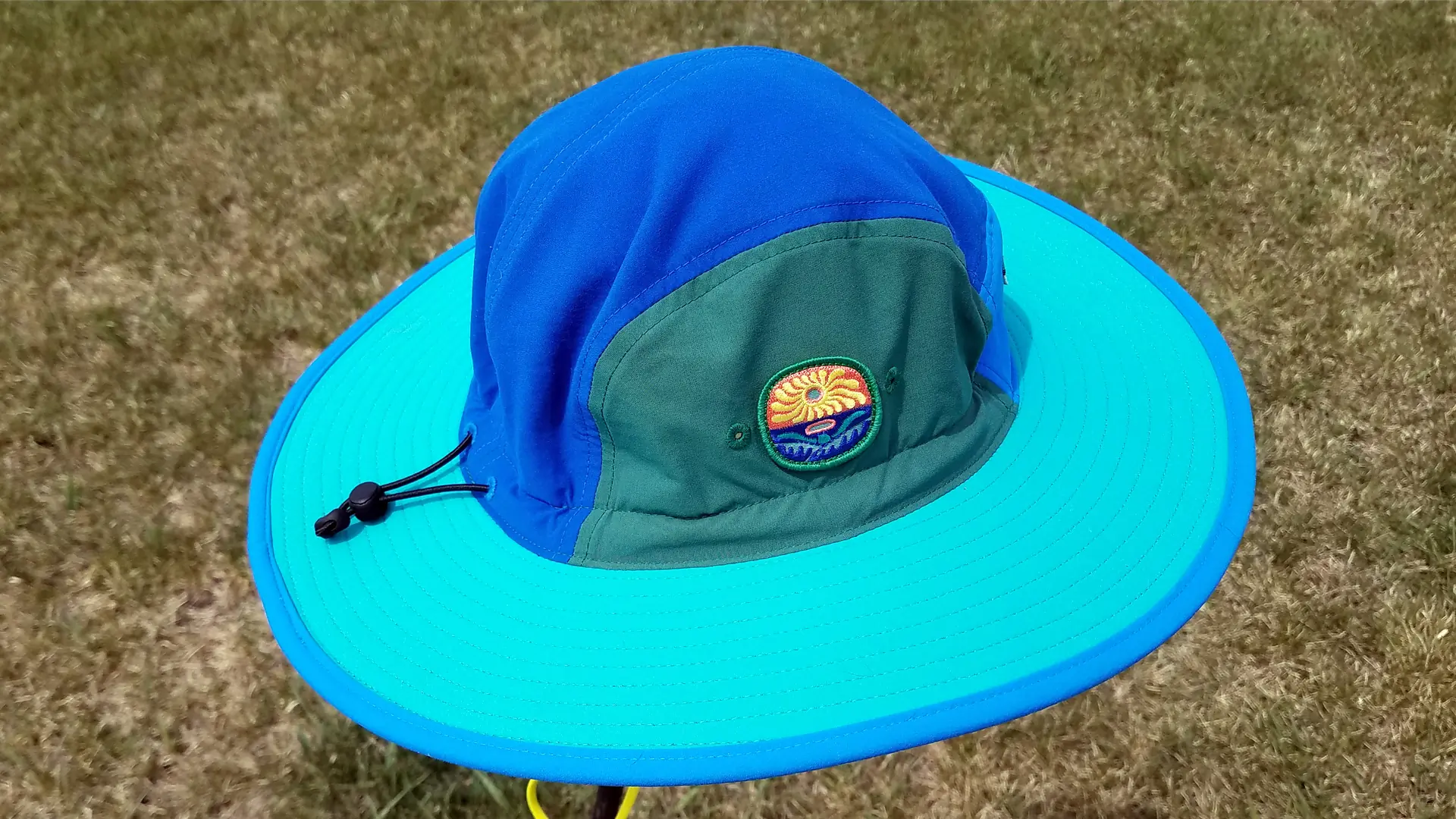



Color
Fish can see color, which is part of why attractor flies like a psycho prince nymph or a red copper john might entice a fish when other imitative flies have lost their luster. While you want a fish to see your fly, you don’t want to startle them with the sudden casting movement of any brightly colored apparel.
It may not be a universal opinion, but fishing hats in neutral or light colors like beige, khaki, or light gray go beyond reflecting sunlight and keeping you cool. They can also keep you from standing out against a bright sky or vegetation behind you.
Some anglers disregard the color advice for the sake of style or just aren’t as concerned that it is an issue. If that is the case for you, and you like an eclectic but vintage look, you’ll want to take a look at the Patagonia Quandary Brimmer in the OG Vessel Blue color. Of course, if you like the hat but don’t want the flashy color pattern, it’s available in more neutral colors.
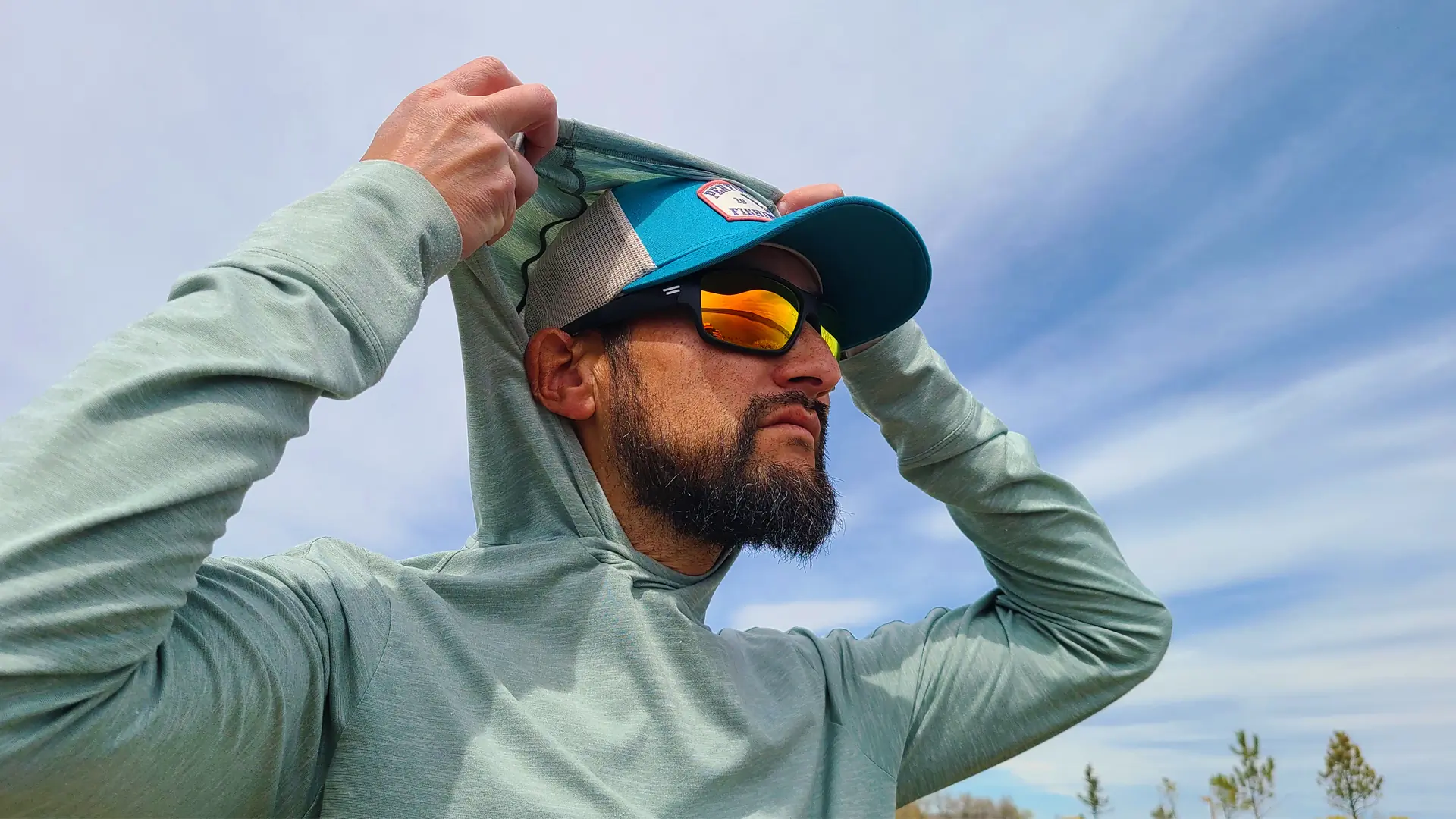



Design
Common fishing hat designs include the iconic straw hat, boonie or bucket hats, and caps like the PFG Uncharted Snapback from Columbia. Some hats are better suited for a backcountry fishing trip or float trip than for pier or jetty fishing. Most straw hats are exceptionally similar in design, but a liner decorated in fun motifs can add a little bit of personal flair.
Boonie or bucket-style hats are also all very similar, but taking a closer look at different hats will highlight differences in design choices from one brand to another. The shape of the crown on boonie and bucket hats ranges from a more structured hat with a lower profile flat top versus the dome shapes of others.
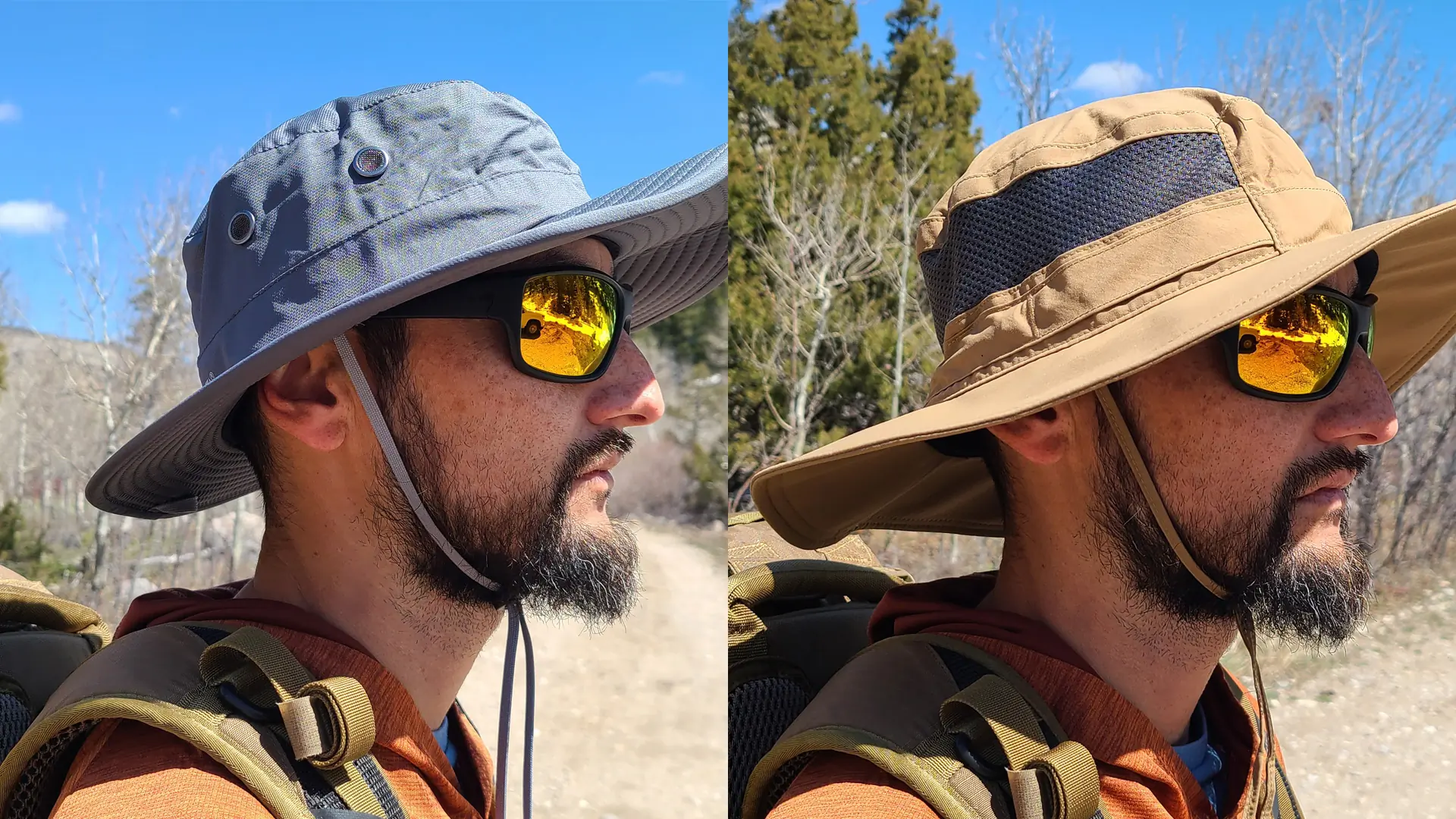



Brim Size
Brim size and design should also be considered when wearing a hat with a pack or fishing from a kayak, where an oversized brim can brush your float vest or just obstruct paddling and casting. The Shelta Seahawk Performance Sun Hat is a perfect example of a good balance of the size of brim and crown design that makes sense for anglers fishing from any sort of small watercraft, as it provides great protection, and stays out of the way for some of the more rigorous types of fishing.
Bucket hats like the Huk Fish and Flags Straw Sun Hat are also distinguished from boonie hats by the brim, which slopes downward more drastically than the flatter brim of a boonie hat but also goes beyond sun protection and moves into the territory of obstructing vision with how far the brim comes down past your brow. The Sunday Afternoons Ultra Adventure Hat offers a hybrid of many designs.
It has a split medium to large-sized brim that folds in half to conveniently pack down and fit in smaller spaces like a large pocket or the brain of a backpack. The cape on the neck also contributes to a lighter weight and versatile design that does not get in the way of backpacks.




Ventilation
Proper ventilation is essential for staying cool and comfortable while fishing. Straw hats like the Grundens Waterman Straw Hat will provide natural ventilation through the woven design.
However, a boonie hat like the Shelta SeaHawk or Columbia Bora Bora promotes airflow and prevents overheating with mesh panels or large ventilation holes strategically placed around the crown. Materials in the headband should also allow for sweat to wick away sweat and moisture.
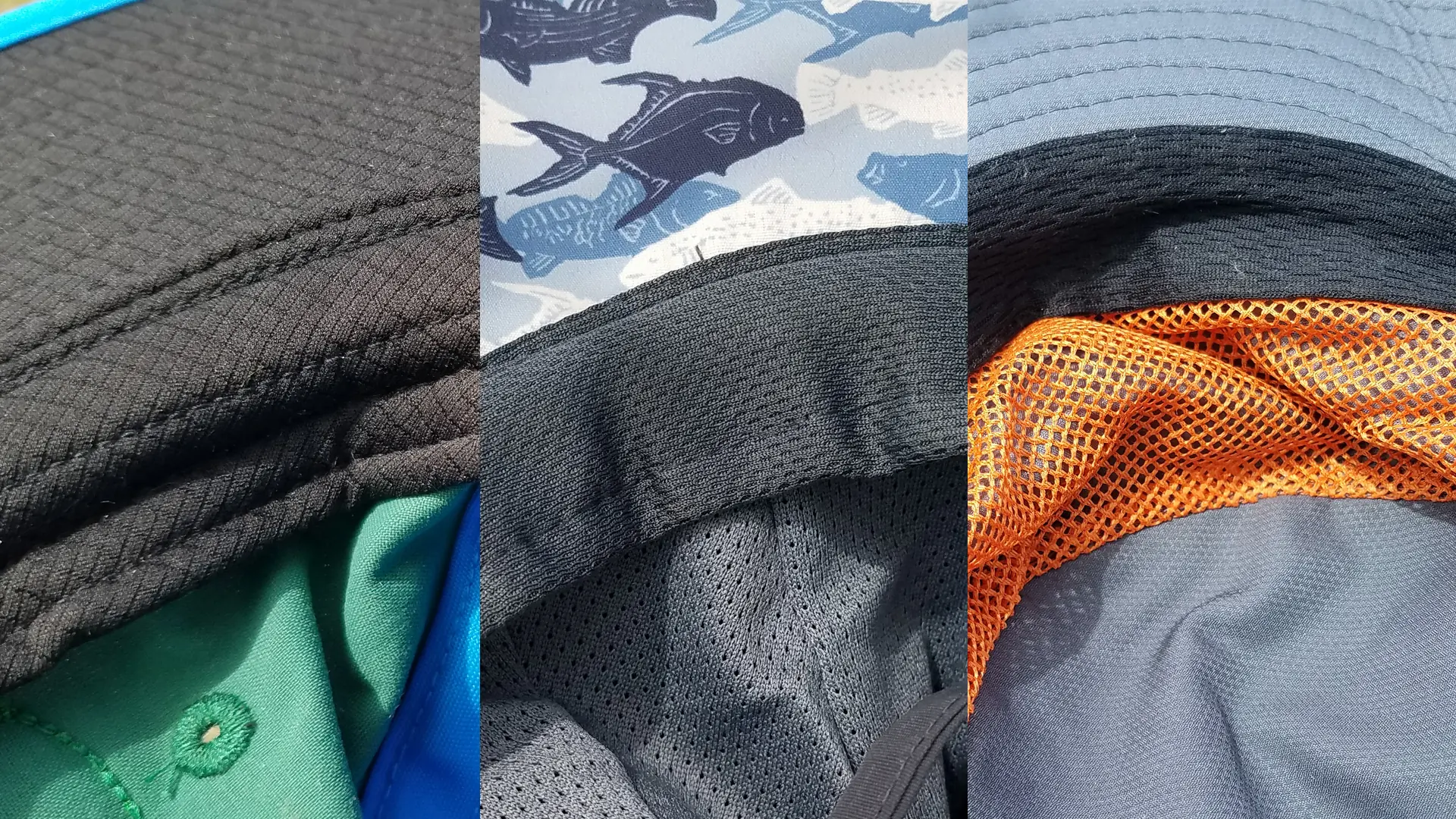



Comfort and Fit
A proper fit is crucial for ensuring comfort while fishing. Look for hats with adjustable features such as cinching headbands, chin straps, elastic, and either hook and loop or adjustable snaps.
While the Simms Superlight Flats Cap won’t protect the back of your neck or ears from the sun, the ultralight hat is easily sized to your head with a hook and loop closure, and once it is on your head, you’ll forget it is there. Avoid too tight or loose hats, as they can cause discomfort. And, like most things that are uncomfortable, you’ll eventually pull it off or stop using it altogether.
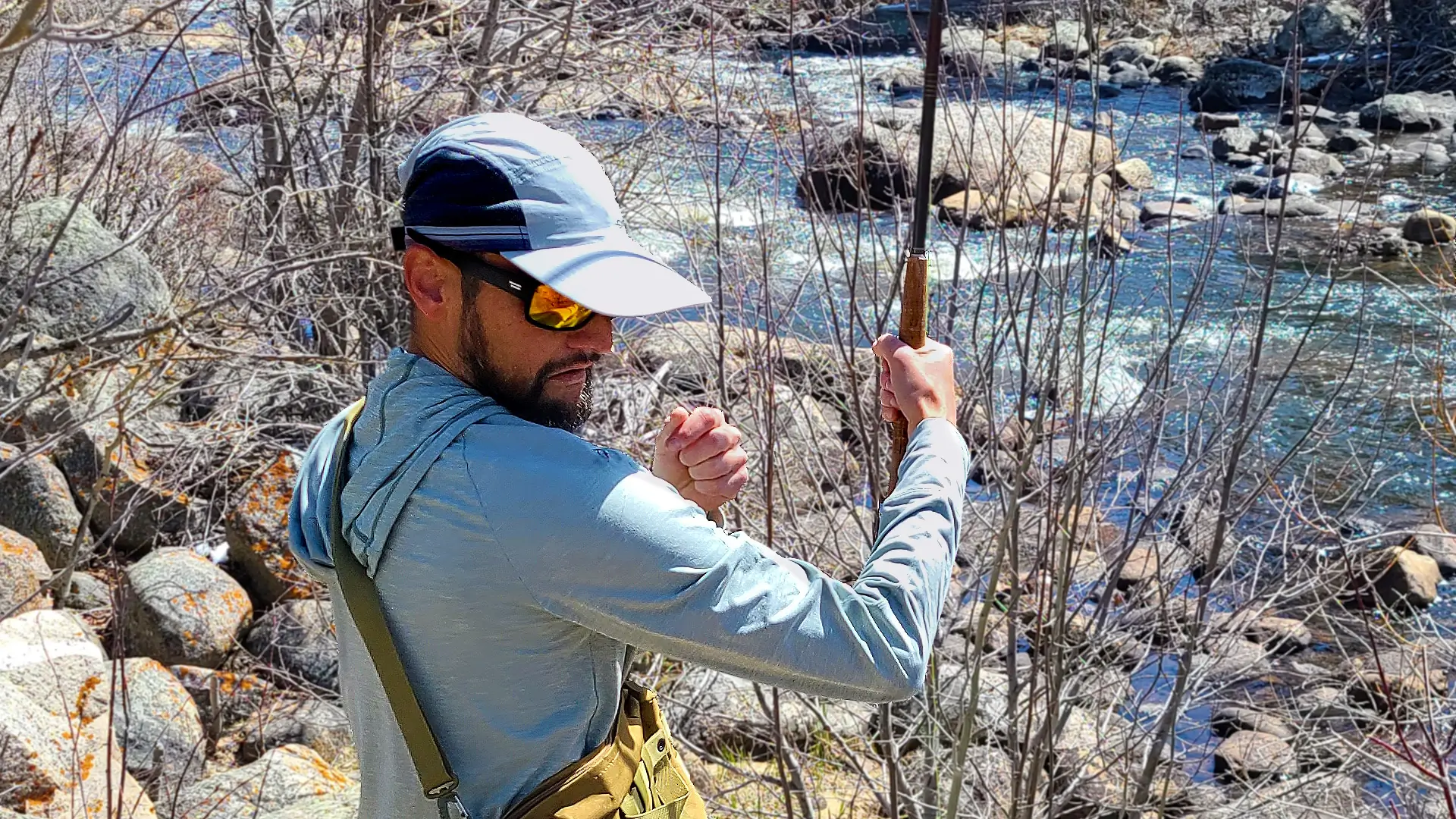



Additional Features
Some fishing hats offer anglers conveniences that enhance comfort, functionality, and versatility. Some more notable features are an integrated crown pocket for folding up and storing a hat and removable chin straps. Some brands also include loops around the crown or brim to attach tackle, sunglasses, flies, or other small items.
Flies attached to a hat are iconic and even romanticized by classic films like “A River Runs Through It.” However, it is arguable whether it is practical to store anything on your hat or not. We have no interest in starting a debate over hat storage. But, we will note that the Columbia Bora Bora II Booney Bucket Hat incorporates loops into the crown design. Consider that model if that’s a feature you believe you want, or even need. A sunglasses holder built into the crown of the Sunday Afternoons Ultra Adventure Hat is also a cool alternative to chums, or gear loops.
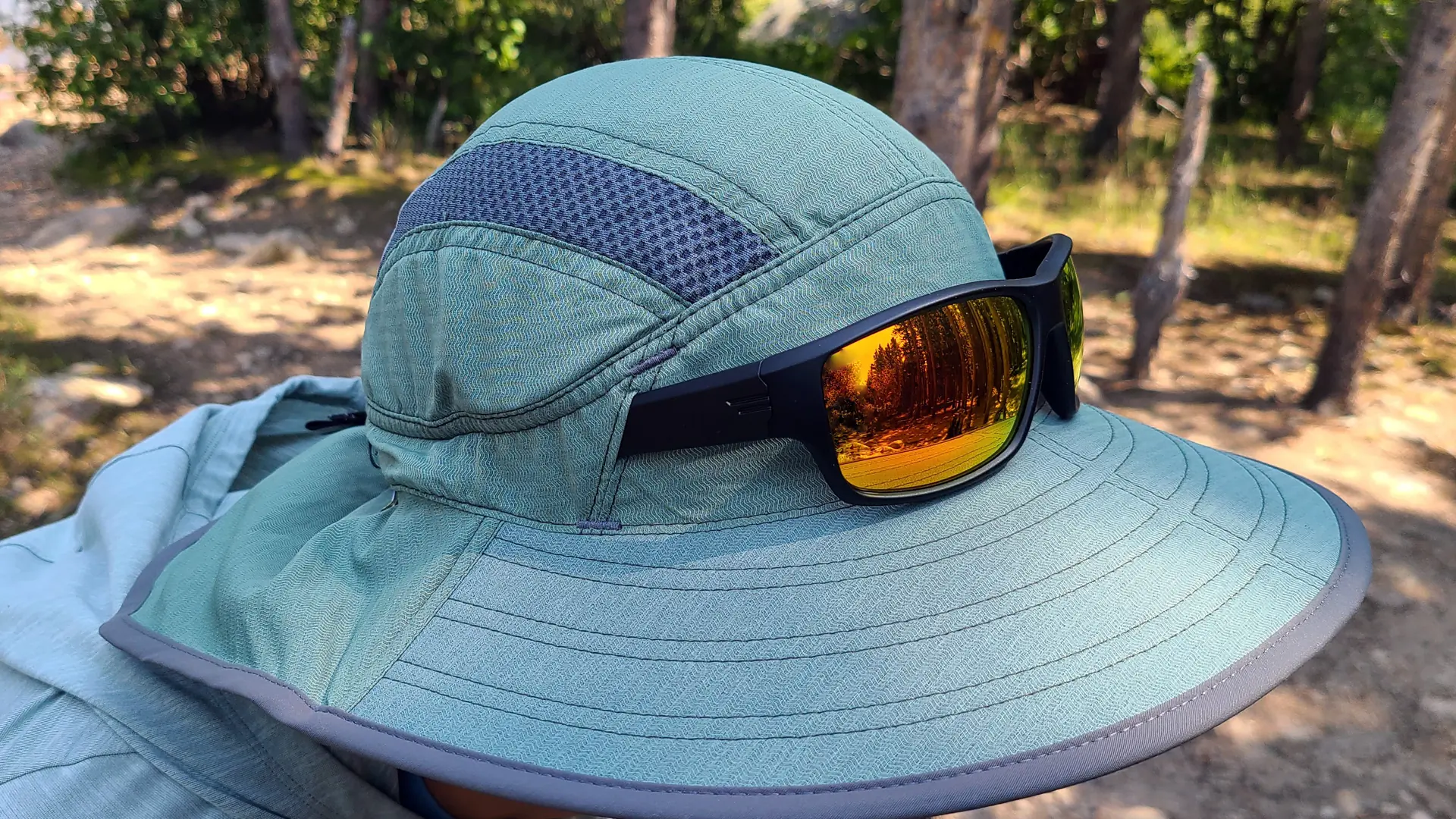



Frequently Asked Questions
The best fishing hat is the one that suits your sun protection, comfort, and fishing needs. No one hat handles all angling situations perfectly. Rather fishermen should have a couple of hats to match angling styles, the day’s specific conditions, and personal preferences.
Anglers may have a variety of hats to choose from, that suit different weather conditions and personal preferences. Common choices include wide-brimmed straw hats for maximum sun protection, boonie or bucket hats for a greater balance of performance and versatility, and caps that range from serious but minimalist to casual. The specific hat worn often depends on factors such as the time of day, weather forecast, and fishing location.
Small nuances in design and utility distinguish a bucket hat from a fisherman’s hat. A bucket hat can be a simple fashion item that helps provide shade from the sun. A fishing hat protects from the sun and rain through the use of UPF-rated synthetic materials that are naturally water-resistant. They may also be treated with a durable water-repellent coating.
Fishing hats also have a broader brim, a glare-reducing underbrim, and a chin strap for added security in windy conditions. Many have cinching or elastic headbands for better fit and comfort. Breathable and moisture-wicking materials are also a normal part of the construction of a fishing hat. The typical cotton bucket hat will do little by comparison to help keep you cool or dry.
A fishing hat, for the most part, is not a fashion statement but a practical piece of equipment that protects from the elements, including the sun’s UV rays. Anglers rely on them to shield their eyes from blinding glare and to stay cool under the scorching sun. They are an indispensable piece of kit and some offer additional features that provide even more functionality.




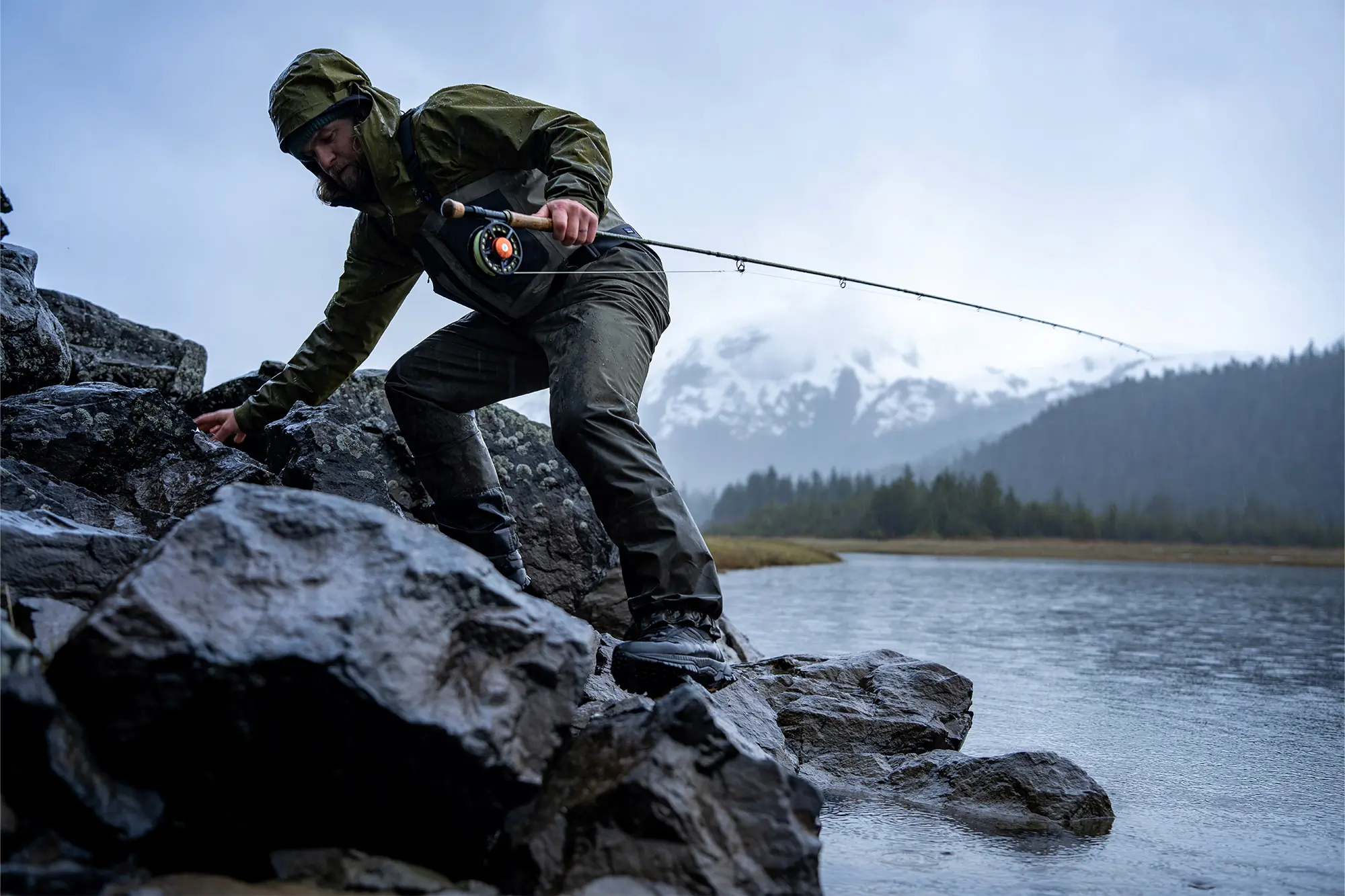

The Best Fishing Waders of 2025
We tested the leading fishing waders , including options from Patagonia, Simms, and Orvis, to find the best of 2025.
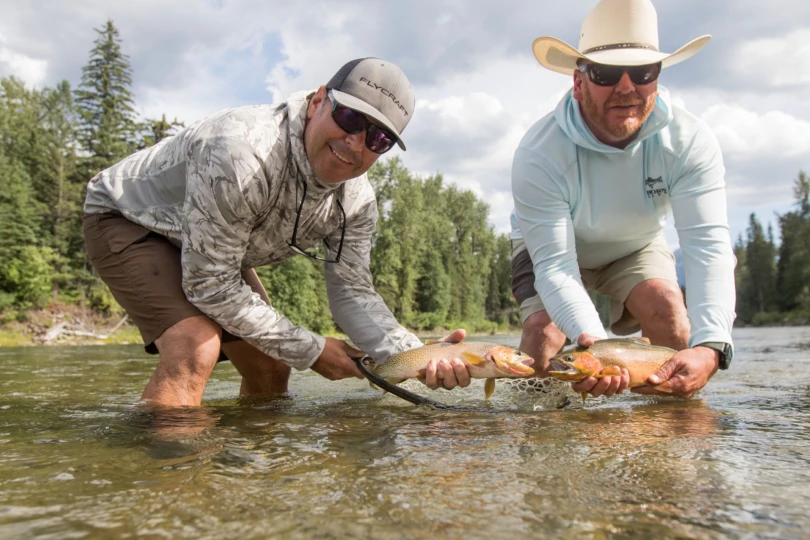

The Best Fishing Sunglasses of 2025
Sunglasses can make or break your success on the water. Without the right pair of glasses, you may not be able to get the job done.

